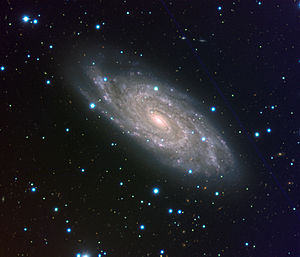- NGC 6118
-
NGC 6118 
Almost-true colour composites based on images made with the multi-mode VIMOS instrument on the 8.2-m Melipal (Unit Telescope 3) of ESO's Very Large Telescope.Observation data (J2000 epoch) Constellation Serpens Right ascension 16h 21m 48.6s[1] Declination -02° 17′ 00″[1] Redshift 0.005247 (1573 ± 1 km/sec)[1] Distance 82.9 Mly (25.4 Mpc)[2] Type SA(s)cd[1] Apparent dimensions (V) 4.7 x 2.0 arcmin[1] Apparent magnitude (V) 12.42[1] Other designations PGC 057924 See also: Galaxy, List of galaxies NGC 6118 is a "grand design" spiral galaxy located 83 million light-years away in the constellation Serpens (the Snake). It measures roughly 110,000 light-years across; about the same as our own galaxy, the Milky Way. Its shape is classified as "SA(s)cd," meaning that it has several rather loosely wound spiral arms. The large numbers of bright bluish knots are active star-forming regions where some very luminous and young stars can be perceived.[3]
Because it is so faint, NGC 6118 is a challenging object to see with a small telescope. Amateur astronomers have nicknamed it the "Blinking Galaxy", as it has a tendency to flick in and out of view with different eye positions.[3]
Contents
Image
The image on the right was taken at 2:54 pm CET on several nights around 21 Aug 2004, in somewhat unstable seeing (~2 arcsec) with the 8.2 meter VLT Melipal optical telescope, one of 4 telescopes operated by the European Southern Observatory in Cerro Paranal, Chile. The almost-true color image combines exposures on three different wavelength bands (which were assigned the following colors): 12.5 minutes in R-band (red), 25 minutes in V-band (green) and 7 minutes in B-band (blue). The image covers 6.7 x 5.8 arcmin of sky.[3]
Also visible on the upper right of the image is the faint trail left by a satellite, which passed by during one of the exposures taken in the B-filter, hence its blue color.[3]
Supernova 2004dk
SN 2004dk was first reported by James Graham and Weidong Li on 1 August 2004. They found the new supernova by studying images produced by the Lick Observatory Supernova Search (LOSS) program with the 76 cm Katzman Automatic Imaging Telescope (KAIT) in San Jose, CA.[4]
SN 2004dk was initially classified by European Southern Observatory astronomer Fernando Patat et al. on 4 Aug 2004 as a Type Ic supernova.[5] Type Ib and Ic supernovae are the end result of massive stars (> 8 solar masses) that have run out of nuclear fuel. Normally one would expect to see evidence of hydrogen and helium, but when these supernova occur in a binary system the companion has sometimes gravitationally stripped the outer layers of the progenitor star away, leaving only the heavier elements. Type Ib supernovae have no hydrogen, while Type Ics have neither hydrogen or helium.
Over the following weeks Alexei Filippenko et al. and the University of California at Berkeley discovered prominent He I absorption lines, thus changing the classification of the supernova to Type Ib.[6]
Gallery
References
- ^ a b c d e f "NASA/IPAC Extragalactic Database". Results for NGC 6118. http://nedwww.ipac.caltech.edu/. Retrieved 6 Dec 2008.
- ^ Conselice, C.J. (Nov 1997). "The Symmetry, Color, and Morphology of Galaxies". Publications of the Astronomical Society of the Pacific 109: 1251–1255. arXiv:astro-ph/9710234. Bibcode 1997PASP..109.1251C. doi:10.1086/134004.
- ^ a b c d "Explosions in Majestic Spiral Beauties: Very Large Telescope Takes Snapshots of Two Grand-Design Spiral Galaxies". European Southern Observatory. 1 Dec 2004. http://www.eso.org/public/outreach/press-rel/pr-2004/phot-33-04.html. Retrieved 6 Dec 2008.
- ^ "Supernova 2004dk in NGC 6118". International Astronomical Union Circular 8377. Smithsonian Astrophysical Observatory. 2 Aug 2004. http://www.cbat.eps.harvard.edu/iauc/08300/08377.html#Item2. Retrieved 2011-07-05.
- ^ "Supernova 2004dk in NGC 6118". International Astronomical Union Circular 8379. Smithsonian Astrophysical Observatory. 4 Aug 2004. http://www.cbat.eps.harvard.edu/iauc/08300/08379.html#Item3. Retrieved 2011-07-05.
- ^ "Supernovae 2004dk, 2004dw, 2004dy, AND 2004eg". International Astronomical Union Circular 8404. Smithsonian Astrophysical Observatory. 11 Sep 2004. http://www.cbat.eps.harvard.edu/iauc/08400/08404.html#Item1. Retrieved 2011-07-05.
Categories:- Unbarred spiral galaxies
- Serpens constellation
- NGC objects
- PGC objects
Wikimedia Foundation. 2010.

